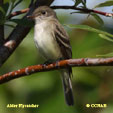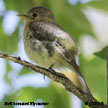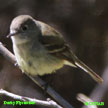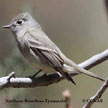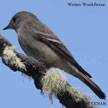Field Guide for all the Birds of North America
North American Flycatchers, Kiskadee, Pewees, Phoebes, Tyrannulet & Wood-Pewees
Kingbirds, Kiskadee, Pewees, Phoebes, Tyrannulet & Wood-Pewees
Moucherolles nord-américains
Muscicapidae & Tyrannidae
Information, images and range maps on over 1,000 birds of North America, including sub-species, vagrants, introduced birds and possibilities
North American Bird Search Box

There are close to twenty species of native flycatchers seen in North America and this does not include the kingbirds, kiskadee, pewee, wood-pewees, phoebes or the tyrannulet. The largest concentration of these different types of birds are in the southern US states. In most cases, flycatchers have duller colours but there are some exceptions, such as the bright red Vermilion Flycatcher or the spectacular looking Scissor-tailed Flycatcher.
Insects are the main diet of these birds and they are known for their aerial acrobatic displays, as they catch flying insects in the air. At times, they stop in mid-flight and hover and pick their prey from the leaves and branches. This type of manoeuvre is known as hawking. The flycatchers prefer high perches where they have the advantage of seeing a larger area as they seek out their prey. The flycatchers are some of the most difficult birds to identify because some species are so similar in size, colour and markings. Sometimes only the bird's call can separate them from each other.
North American Birds Videos
- Click here
Reference to Other Bird Site:
ABA - American Birding Association This site represents an organization that maintains official records of all birds species that have been proven to have been seen inside the perimeters of the North American Continent and the surrounding bodies of water. Regular revised versions are posted to keep the bird list current at all times. This is the list used by all serious birders over their lifetime. You may be aware of the movie called the "Big Year". It was with this list that all the competing birders used in an attempt to set a new record as to how many bird species that could be seen by an individual birder in one calendar year.

